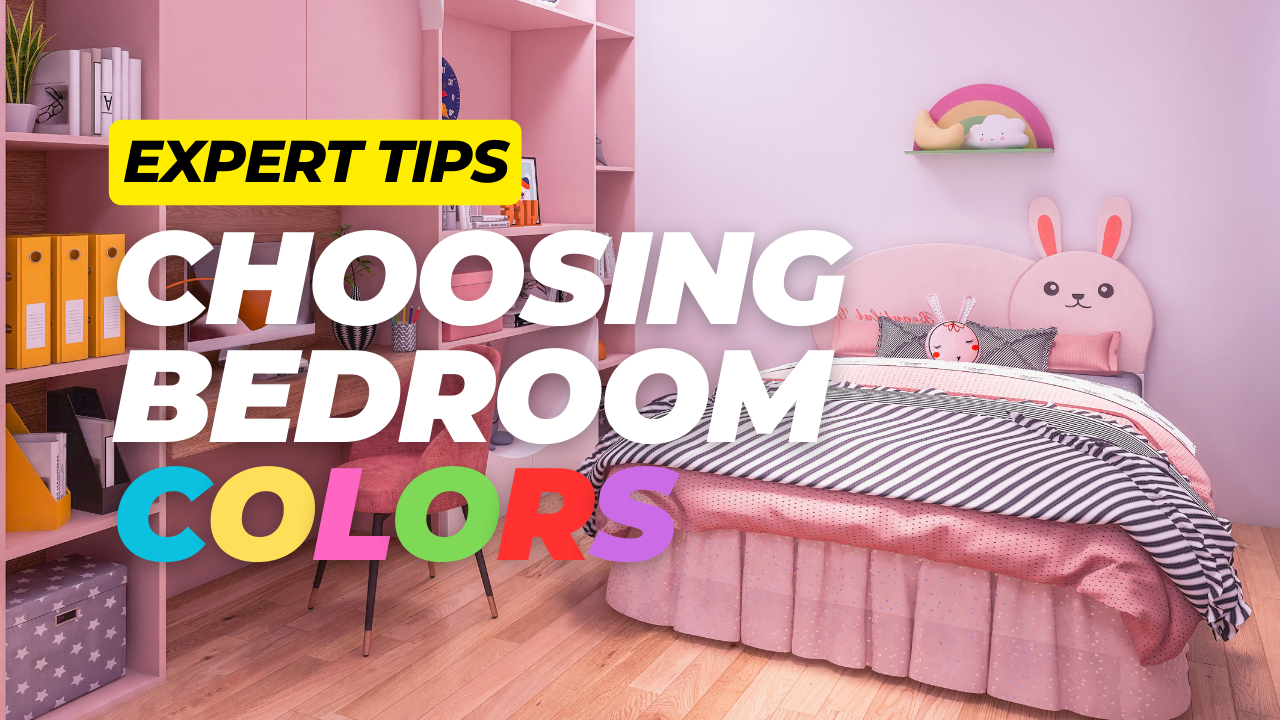Expert Tips On Choosing Bedroom Colors

The bedroom is more than just a place to sleep; it’s a sanctuary for rest, rejuvenation, and personal expression. The colors we choose for this intimate space can significantly impact our mood, sleep quality, and overall well-being. In this comprehensive guide, we’ll explore the fascinating world of color psychology in bedrooms, delving into the best colors for relaxation, popular trends, and practical tips for creating your perfect sleep haven.
Understanding Color Psychology
Color psychology is the study of how colors affect human behavior, emotions, and physiological responses. In the context of bedroom design, understanding these principles can help create an environment that promotes relaxation, fosters restful sleep, and enhances overall comfort.
Explanation of color psychology
Color psychology is based on the idea that different colors evoke specific emotional and physical responses in humans. This concept has roots in both scientific research and cultural associations. While individual experiences and cultural backgrounds can influence color perceptions, certain general principles tend to hold true across various contexts.
- Warm colors (reds, oranges, yellows) are often associated with energy, excitement, and warmth.
- Cool colors (blues, greens, purples) typically evoke feelings of calmness, relaxation, and serenity.
- Neutral colors (whites, grays, beiges) can create a sense of balance, sophistication, and versatility.
Understanding these basic principles can guide you in selecting the most appropriate colors for your bedroom, based on the atmosphere you wish to create.
How different colors influence mood and relaxation
The impact of colors on mood and relaxation is multifaceted and can vary depending on the specific shade, intensity, and context in which the color is used. Here’s a breakdown of how different color families can influence the bedroom environment:
| Color Family | Mood Influence | Relaxation Effect |
| Blues | Calmness, serenity | High |
| Greens | Natural, refreshing | High |
| Purples | Luxurious, mysterious | Moderate |
| Reds | Passionate, energetic | Low |
| Oranges | Warm, sociable | Low |
| Yellows | Cheerful, optimistic | Moderate |
| Neutrals | Balanced, sophisticated | High |
It’s important to note that within each color family, different shades can have varying effects. For example, a soft, pale blue might be more conducive to relaxation than a bright, electric blue. Similarly, a muted sage green may be more calming than a vibrant lime green.
When selecting colors for your bedroom, consider not only the general color family but also the specific shade and intensity that best aligns with your desired mood and relaxation goals.
Calming Colors for a Bedroom
When it comes to creating a serene and relaxing bedroom environment, certain colors stand out as particularly effective. Let’s explore some of the most popular and psychologically beneficial colors for promoting calmness and restfulness in the bedroom.
Blue: Promotes tranquility and calmness
Blue is often considered the ultimate color for relaxation and tranquility in bedroom design. Associated with the vast expanse of the sky and the serene depths of the ocean, blue has a natural ability to induce feelings of calmness and peace.
- Light blues: Shades like sky blue, powder blue, and pale aqua can create a sense of openness and airiness in the bedroom. These lighter tones are particularly effective in smaller spaces, as they can make the room feel larger and more spacious.
- Medium blues: Tones such as periwinkle, cornflower blue, and steel blue offer a balance between serenity and depth. These shades can add a touch of sophistication while still maintaining a calming atmosphere.
- Dark blues: Navy, indigo, and midnight blue can create a cozy, cocoon-like feeling in the bedroom. These deeper shades are particularly suitable for larger bedrooms or as accent colors.
Studies have shown that exposure to blue can lower blood pressure and heart rate, making it an excellent choice for promoting restful sleep. When using blue in your bedroom, consider pairing it with white or neutral tones to create a fresh, clean look that enhances the calming effect.
Green: Brings a sense of nature and serenity
Green, the color most associated with nature, is another excellent choice for creating a serene bedroom environment. It evokes feelings of growth, harmony, and balance, making it particularly suitable for those seeking a connection with the natural world in their sleep space.
- Soft greens: Shades like sage, mint, and seafoam green are gentle on the eyes and can create a soothing, refreshing atmosphere. These lighter tones work well as all-over wall colors or as accents in bedding and decor.
- Mid-tones: Colors such as olive, moss, and forest green can add depth and richness to the bedroom while still maintaining a calm ambiance. These shades pair beautifully with natural wood tones and earthy textures.
- Dark greens: Deep emerald or hunter green can create a luxurious, enveloping feeling in the bedroom. These bold shades work well as accent walls or in smaller doses through furniture and accessories.
Green is known to promote feelings of balance and harmony, making it an excellent choice for those who want to create a restful yet rejuvenating bedroom space. Consider incorporating plants or nature-inspired artwork to enhance the connection with the outdoors and amplify the calming effects of green.
Neutrals: Create a soothing and versatile backdrop
Neutral colors, including various shades of beige, gray, and white, offer a timeless and versatile foundation for bedroom design. These colors create a sense of calm and order, allowing other elements in the room to take center stage.
- Warm neutrals: Shades like beige, taupe, and warm gray can create a cozy, inviting atmosphere in the bedroom. These colors pair well with natural textures and materials, enhancing the overall sense of comfort.
- Cool neutrals: Colors such as light gray, silver, and crisp white can create a clean, modern look in the bedroom. These shades are particularly effective in brightening up spaces with limited natural light.
- Rich neutrals: Deeper tones like charcoal gray, chocolate brown, and greige (a combination of gray and beige) can add sophistication and depth to the bedroom while still maintaining a calming presence.
The beauty of neutral colors lies in their flexibility. They provide a soothing backdrop that can be easily accessorized with pops of color through bedding, artwork, or decorative objects. This versatility allows you to change the look and feel of your bedroom with minimal effort, simply by swapping out accent pieces.
When using neutrals, pay attention to texture and layering to add visual interest and depth to the space. Consider incorporating a variety of materials such as linen, wool, and velvet to create a rich, inviting atmosphere that complements the calming color palette.
Energizing Colors for a Bedroom
While calming colors are typically favored for bedrooms, there may be instances where you want to incorporate more energizing hues. These colors can add warmth, positivity, and a touch of vibrancy to your sleep space without compromising on relaxation.
Yellow: Adds warmth and positivity
Yellow is often associated with sunshine, happiness, and optimism. When used thoughtfully in bedroom design, it can create a cheerful and uplifting atmosphere that energizes you in the morning and promotes a positive mood throughout the day.
- Pale yellows: Soft shades like butter yellow, lemon chiffon, and pale gold can add a subtle warmth to the bedroom without being overwhelming. These lighter tones work well as all-over wall colors or in larger doses through bedding and curtains.
- Mid-tone yellows: Colors such as mustard, honey, and marigold can create a cozy, inviting atmosphere. These richer shades are particularly effective as accent colors or in smaller doses through decorative elements.
- Bright yellows: Vibrant shades like sunflower yellow or citron should be used sparingly in the bedroom, perhaps as accent pieces or in artwork, to avoid overstimulation.
When incorporating yellow into your bedroom, balance it with neutral tones or cooler colors to prevent the space from feeling too intense. For example, pairing yellow with gray can create a sophisticated and balanced color scheme that is both energizing and relaxing.
Soft Pinks: Contribute to a calming yet uplifting atmosphere
Pink, particularly in its softer shades, can create a soothing yet gently energizing atmosphere in the bedroom. Often associated with love, compassion, and nurturing, pink can contribute to a sense of comfort and well-being.
- Blush pink: This soft, muted shade of pink adds a touch of warmth and femininity to the bedroom without being overpowering. It pairs beautifully with neutral tones and can create a serene, romantic atmosphere.
- Dusty rose: A slightly deeper, more muted pink that can add sophistication and depth to the bedroom. This shade works well as an accent color or in larger doses for a more dramatic effect.
- Coral: A blend of pink and orange, coral adds a warm, tropical feel to the bedroom. It can be energizing without being as intense as pure orange or red.
When using pink in the bedroom, consider balancing it with cooler tones like gray or blue to create a well-rounded color scheme. You can also pair pink with metallic accents, such as gold or copper, for a touch of glamour and sophistication.
Popular Bedroom Color Schemes
Creating a cohesive and harmonious bedroom color scheme involves more than just selecting a single color. By understanding how different colors work together, you can create a balanced and visually appealing space that promotes relaxation and reflects your personal style.
Monochromatic schemes
A monochromatic color scheme uses variations of a single color, incorporating different shades, tones, and tints to create depth and interest. This approach can create a serene and unified look in the bedroom.
- Benefits:
- Creates a cohesive and harmonious look
- Easy to coordinate furniture and accessories
- Can make a small room appear larger
- Examples:
- Shades of blue: Pale sky blue walls with navy bedding and medium blue accents
- Green palette: Sage green walls with forest green curtains and mint green accessories
- Gray variations: Light gray walls with charcoal bedding and silver accents
To prevent a monochromatic scheme from feeling flat, incorporate a variety of textures and patterns within the chosen color family. This adds visual interest and depth to the space.
Complementary color schemes
Complementary color schemes use colors that are opposite each other on the color wheel. When used in the right proportions, these contrasting colors can create a dynamic and visually striking bedroom design.
- Benefits:
- Creates visual excitement and energy
- Allows for bold color combinations
- Can highlight specific areas or elements in the room
- Examples:
- Blue and orange: Navy blue walls with coral or terracotta accents
- Purple and yellow: Lavender walls with mustard yellow accessories
- Green and red: Sage green walls with burgundy or maroon accents
When using complementary colors in the bedroom, it’s often best to use one color as the dominant shade and the other as an accent. This prevents the scheme from becoming too overwhelming or energetic for a sleep space.
Analogous color schemes
Analogous color schemes use colors that are adjacent to each other on the color wheel. This approach creates a harmonious and balanced look that can be both soothing and visually interesting.
- Benefits:
- Creates a harmonious and cohesive look
- Offers more variety than a monochromatic scheme
- Can be calming and easy on the eyes
- Examples:
- Blue, green, and purple: Soft blue walls with sage green bedding and lavender accents
- Yellow, orange, and red: Pale yellow walls with peach bedding and coral accessories
- Green, blue, and teal: Mint green walls with powder blue curtains and teal accents
Analogous color schemes work well in bedrooms because they create a sense of harmony and balance. To add depth to this type of scheme, vary the intensity and saturation of the chosen colors.
Tips for Choosing the Right Color Scheme
Selecting the perfect color scheme for your bedroom involves more than just picking colors you like. Consider the following factors to ensure your chosen palette creates the desired atmosphere and works well within your space.
Considering the room size and natural light
The size of your bedroom and the amount of natural light it receives can significantly influence how colors appear and feel in the space.
- Small bedrooms:
- Light colors can make the room feel larger and more open
- Consider using a monochromatic scheme with varying shades of a light color
- Use mirrors to reflect light and create the illusion of more space
- Large bedrooms:
- Can accommodate darker or bolder colors without feeling cramped
- Consider using an accent wall to add depth and interest
- Use color to create distinct zones within the room (e.g., sleeping area, reading nook)
- Rooms with limited natural light:
- Opt for lighter, brighter colors to maximize the available light
- Consider using glossy or metallic finishes to reflect light
- Use warm-toned lighting to create a cozy atmosphere
- Rooms with abundant natural light:
- Can handle a wider range of colors, including darker shades
- Consider how the light changes throughout the day when selecting colors
- Use window treatments to control light and protect colors from fading
Matching with bedroom furniture and decor
Your color scheme should complement your existing furniture and decor, or vice versa if you’re starting from scratch.
- Wood furniture:
- Warm colors like browns, reds, or yellows can enhance the natural warmth of wood
- Cool colors can provide an interesting contrast to warm wood tones
- Consider the undertones of your wood furniture when selecting wall colors
- White or light-colored furniture:
- Offers flexibility to use bolder wall colors or vibrant accents
- Can create a fresh, clean look when paired with light or neutral walls
- Consider using textured fabrics or patterns to add depth to a light color scheme
- Existing artwork or textiles:
- Use colors from favorite pieces as inspiration for your overall scheme
- Consider using the dominant color of artwork as an accent color in the room
- Ensure that the wall color doesn’t compete with or overpower important decor elements
Balancing bold and neutral tones
Creating a balanced color scheme often involves combining bold and neutral tones effectively.
- 60-30-10 rule:
- Use 60% of a dominant color (often a neutral)
- 30% of a secondary color
- 10% of an accent color
- Accent walls:
- Use a bold color on one wall while keeping others neutral
- Can create a focal point in the room
- Consider using wallpaper or textured paint for added interest
- Neutral base with colorful accessories:
- Keep walls and large furniture pieces neutral
- Add color through easily changeable elements like bedding, curtains, and decor
- Allows for flexibility to change the look of the room without major renovations
Remember, the key to a successful bedroom color scheme is creating a balance that promotes relaxation while reflecting your personal style.
Bedroom Color Trends for 2024
Staying informed about current and upcoming color trends can provide inspiration for your bedroom design. While it’s important to choose colors that resonate with you personally, understanding trends can help you create a contemporary and stylish space.
Current trends in bedroom paint colors
The current bedroom color trends reflect a desire for calm, natural environments that promote well-being and relaxation.
- Earthy tones:
- Colors like terracotta, clay, and warm browns are gaining popularity
- These shades create a grounding, comforting atmosphere
- Pair with natural textures and materials for a cohesive look
- Soft neutrals:
- Subtle hues like cream, linen, and light gray continue to be favored
- These colors provide a calming, timeless backdrop
- Easily adaptable to various design styles and accent colors
- Organic greens:
- Nature-inspired greens like sage, olive, and forest green are trending
- These colors bring a sense of the outdoors into the bedroom
- Can be used as all-over color or as accents with neutral backgrounds
Predictions for upcoming popular colors
Looking ahead, several color trends are expected to gain momentum in bedroom design:
- Deep blues:
- Navy, indigo, and midnight blue are predicted to rise in popularity
- These colors add sophistication and depth to bedrooms
- Can be used as accent walls or in larger doses for a cocooning effect
- Warm neutrals:
- Shades like beige, camel, and warm gray are expected to trend
- These colors create a cozy, inviting atmosphere
- Versatile enough to work with various design styles and accent colors
- Blushed tones:
- Soft pinks, peaches, and coral hues are gaining traction
- These colors add warmth and femininity to bedroom spaces
- Can be used as subtle accents or in larger doses for a romantic feel
When considering these trends, remember that the most important factor is choosing colors that resonate with you and create the atmosphere you desire in your bedroom. Trends can provide inspiration, but your personal preferences and the specific needs of your space should guide your final decisions.
Conclusion
Choosing the right colors for your bedroom is a deeply personal decision that can significantly impact your mood, sleep quality, and overall well-being. By understanding color psychology and considering





